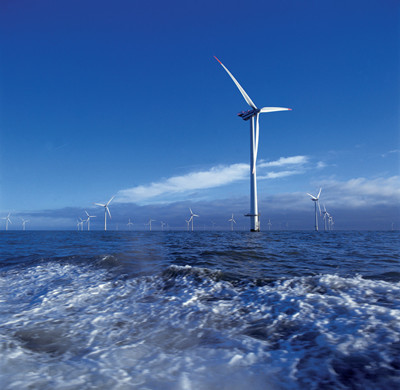(单词翻译:单击)

The use of wind power continues to soar around the world. In 2008 the U.S. actually surpassed Germany as the world’s top producer of energy from wind. It might seem that there aren't many improvements to make to what's essentially a passive technology. But researchers at the California Institute of Technology say the way fish school will help create more efficient designs for wind farms. They presented their research at a meeting of the American Physical Society's Division of Fluid Dynamics.
世界各国对风能的利用在持续猛增,截止2008年,美国已经超越德国,成为世界第一风能大国。一般认为,对于风能这种依赖于自然条件的能源,似乎没有办法再做多少改进了。不过,来自加州理工学院的研究者们却称,通过对鱼群的仿生学习,能够设计出效能更高的风力发电厂。这项研究发布于美国物理学会流体动力学分会的一次学术会议上。
When fish swim, they leave little swirling vortices in their wake. By swimming together in a school, they can transfer energy to one another through these vortices. Wind behaves much as a liquid does. So the engineers have taken wind turbines that spin on vertical axes—these are different from the traditional horizontal wind turbine mostly in use today. On a computer, they've positioned the turbines close enough together that as one spins, it then directs the wind to its neighbor.
当鱼儿游来游去时,在它们的航迹里会留下小小的漩涡。当鱼群游动在一起时,它们能通过这些漩涡相互借力。风的运动与流体类似,工程师们把风力涡轮机装置在一个纵向的中轴上——这与当下应用的横向放置的传统风力涡轮机截然不同。工程师们在电脑上对这些风力涡轮机进行了模拟,并让它们的位置尽可能地靠近,这样当一台涡轮机转动时,它也能将风导向临近的那台风力涡轮机。
According to the computer model, this design could increase wind farm efficiency a hundred-fold. The next step for the researchers is to do a field test, trying out these fish dynamics on dry land.
根据这个电脑模型,这样设计出的风力发电厂效能将能比现在提高一百倍。研究者们接下来要做的,就是按照模型设计出一个实验风力发电站,看看能不能将从鱼群身上学到的智慧转化成实实在在的风能。


